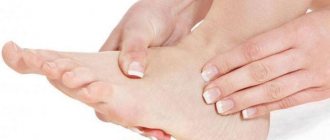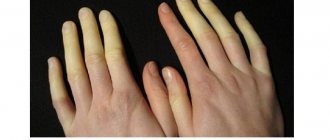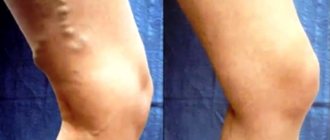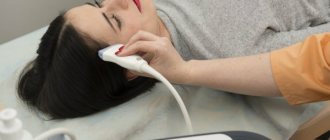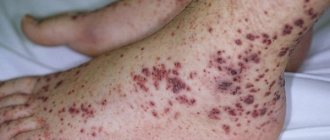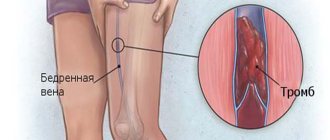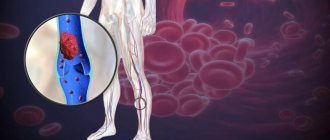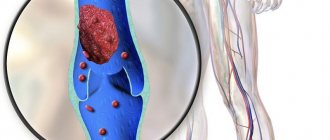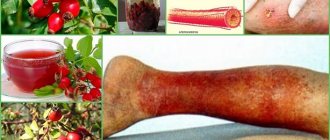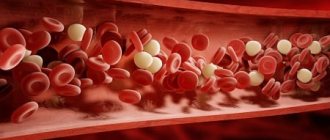1
Author of the article: Marina Dmitrievna
2017.11.03
25 638
Vessels
Every third case of sudden death is the result of pulmonary embolism. These are sad statistics. In this regard, the word “thrombus” evokes negative associations in most people.
Meanwhile, thrombus formation is a natural protective process for a healthy body. If blood clots did not form, a person could bleed to death even with a small scratch. Blood clots literally seal damage to blood vessels, and then dissolve when the walls of the vessels restore their integrity.
The detached thrombus moves along the bloodstream
However, thrombus formation can also be pathological. In this case, doctors talk about thrombosis. With this disease, blood clots form in the vessels, preventing normal blood flow. If thrombosis is combined with inflammation of the venous wall, thrombophlebitis is diagnosed.
The famous triad of the German doctor Virchow, explaining the basic reasons for the formation of blood clots
Causes of blood clots on the arm
Thrombophlebitis of the upper extremities is a venous disease that is provoked by the inflammatory process of vascular tissues. In addition, blood clots on the arm are the beginning of the process of thrombus formation, which blocks blood flow by clogging the venous lumens. There is also a problem with blood movement throughout the body. A blood clot on the arm, a photo of which is presented in our article, can be located in different places. For example, a blood clot can be seen under the collarbone in the chest area, on the surface of the veins in the arms, as well as in the deep trunks of the venous vessels of the upper extremities.
Symptoms of a blood clot in the arm can manifest themselves after various inflammations that have a focal location. In some cases, the reason lies in a general inflammatory process that affects the entire body of the patient.
Thrombosis develops after a long stagnation of fluid in the venous vessels, which is formed due to abundant accumulation of tissue due to varicose veins, in the absence of an active lifestyle, as well as in obesity.
In addition to all this, the development of the disease can occur due to injury to blood vessels. This should include accidents and injuries in the event of an incorrect injection.
It should be noted that the development of the disease is influenced by the thickness of the blood. The viscous liquid is held in a vessel with rigid vein walls. Blood becomes thick during pregnancy, as well as when sugar levels are high. A similar symptom may occur in the case of a hereditary disease.
Thus, we can say that thrombosis is based on 3 main signs:
- Slow blood circulation.
- Damage to the walls of the venous vessel.
- Blood clotting too quickly.
What is the danger?
Due to poor circulation, the patient may notice numbness in the hands.
If thrombophlebitis is not treated in a timely manner, it can have dangerous consequences for the health and life of the patient. Even a blood clot formed on a finger can negatively affect blood circulation throughout the body. In this case, the development of venous insufficiency is likely, which leads to the following complications:
- constant numbness of the hands, swelling, night cramps;
- regular attacks of pain, which worsen with weather changes;
- problems holding objects in the affected hand.
Failure does not pose as great a danger to the patient's life as thromboembolism. With such a violation, a blood clot or part of it breaks off and moves through the blood vessels with the blood flow. If a blood clot clogs the pulmonary artery, then cardiac or respiratory failure rapidly develops, leading to the death of the patient.
Predisposing factors
We continue to look at the causes and signs of a blood clot in the arm. Doctors also identify some factors that are considered provoking. These include:
- An inflammatory process that develops after injection. As a rule, it appears in the case of long and regular intravenous drips, catheters, injections, as well as an incorrectly placed injection. These procedures are considered one of the main factors in provoking venous pathology. Quite often, this disease is diagnosed in those patients who take drugs.
- Strong physical activity can lead to a special type of disease called effort thrombosis. The disease is localized in the veins of deep characteristics. It is located under the collarbone and also in the armpit area.
Other factors influencing the development of the disease include:
- Complications during childbirth.
- Genetic predisposition.
- Allergic reaction to medications.
- Surgical intervention.
- Fixing a limb in the same position for a long time.
- Sepsis.
- Paralysis after stroke.
- Bite of a blood-sucking insect.
- Diseases of blood vessels and heart.
- Oral contraceptives.
- Obesity.
- Mature age.
The appearance of thrombosis of the upper extremities is often observed after an infectious disease that provokes dehydration. If there is too little fluid in the human body, the blood thickens, which can lead to stagnation and blockage of the lumen of the veins.
What does a blood clot in the arm look like and what can it lead to?
The materials are published for informational purposes only and are not a prescription for treatment! We recommend that you consult a hematologist at your medical institution!
Co-authors: Natalya Viktorovna Markovets, hematologist
Thrombophlebitis of the upper extremities can affect superficial or deep veins. How does thrombosis develop in the hands, what are its causes and symptoms? It is important to recognize the disease in time, and the treatment prognosis will be favorable.
- Causes of hand thrombosis
- Clinical signs
- Diagnostic methods
- How to treat?
Impaired blood flow as a result of the formation of blood clots in the vessels leads to the development of thrombosis, which is often life-threatening. In medical practice, thrombosis of the lower extremities is most common, but blood clots can also form in other vessels and affect other organs or areas of the body.
Arm thrombosis is considered a fairly rare disease, in which blood clots (thrombi) form in the veins, disrupting normal blood flow. The thrombus can have different sizes and block the blood flow partially or completely.
The disease can affect both superficial and deep veins, but regardless of the location of the blood clot, treatment should be carried out as quickly as possible and only under the supervision of a phlebologist.
Elderly people, as well as those who prefer to use drugs, are at risk for developing thrombosis.
Important! Thrombophlebitis of the upper extremities in most cases is not an independent disease, but develops against the background of other disorders occurring in the body. Mostly, a blood clot in the arm is localized in the area of the subclavian vein or on the veins of the arms.
Causes of hand thrombosis
There are many reasons and predisposing factors for the development of thrombosis in the arm, but in 80% of cases the disease develops against the background of improper catheterization of a vein, after injections, during long-term infusion therapy, or in drug addicts. The reasons for the development of thrombophlebitis in the hands can also occur as a result of the following factors:
- allergic reaction to long-term use of certain medications;
- local hand injuries with severe damage to the veins;
- bite of blood-sucking insects;
- long-term immobilization of the upper limb for fractures;
- diseases of purulent origin affecting the hands: phlegmon, septic conditions;
- increased blood clotting;
- hereditary thrombophilia;
- pathologies of the cardiovascular system;
- elderly age;
- physical inactivity;
- metabolic disorders: diabetes, obesity.
We also recommend that you pay attention to the article: Symptoms and treatment of a blood clot in the heart.
Considering the peculiarities of the human body, these are not all the reasons that can provoke circulatory disorders in the upper extremities with the subsequent formation of a blood clot.
Clinical signs
Symptoms of thrombosis in the arm directly depend on the depth of the damaged veins, the localization of the pathological process, and the characteristics of the human body. When thrombophlebitis affects the superficial veins of the upper extremities, the following symptoms are present:
- Severe pain of varying intensity along the venous trunk.
- Redness and swelling of the skin over the damaged vein.
- When palpating the vein, it is dense.
- Venous vessels are clearly visible through the skin.
- The cervical and axillary lymph nodes are enlarged.
- Body temperature rises.
- The mobility of the hand is impaired, the slightest movements increase the pain.
When deep veins are affected by thrombophlebitis, the signs of the disease are slightly different:
- Swelling and blue discoloration of the hand in the area of the blockage.
- Severe and acute pain in the area of injury.
- Limited movement of the damaged joint.
- General intoxication of the body: increased weakness, fatigue.
We recommend studying the article on a similar topic “What is intestinal thrombosis” within the framework of this material.
In some cases, migrating thrombophlebitis may develop, which indicates blood poisoning. In such cases, multiple nodes will be noticeable under the skin, blocking the blood vessels. Regardless of the depth of the damage to the veins in the arms, treatment should be carried out as quickly as possible. The sooner a person seeks help from doctors, the greater the chance of a successful recovery.
Diagnostic methods
The diagnosis of thrombophlebitis of the upper extremities is made based on the results of examination of the hand. The doctor also collects the patient’s complaints and studies the medical history. To make a final diagnosis, the patient is prescribed a number of laboratory and instrumental studies:
- Laboratory analysis of blood and urine.
- Vascular ultrasound.
- X-ray.
- Blood tests for hormones.
- Blood clotting test.
If necessary, the patient may be prescribed other research methods that will help identify the cause and select the most optimal treatment.
Important! With thrombophlebitis of the superficial veins of the arm, the prognosis is favorable in 80% of cases. If deep vein damage occurs, treatment is longer and often requires surgery.
How to treat?
Treatment of thrombosis in the arm is carried out by a phlebologist and includes a set of therapeutic measures aimed at eliminating the symptoms of the disease, vascular patency, and restoring blood circulation in the veins and vessels.
Complex treatment consists of bed rest, diet, and medications. Fried, spicy, fatty foods should be excluded from the patient’s diet, and alcohol should also be avoided. A nutritious diet should include vegetable fats, dairy products, fresh vegetables and other healthy foods.
Read also on the topic of nutrition for deep vein thrombosis of the lower extremities in addition to the current article.
Drug treatment will improve the patient’s condition and relieve the symptoms of the disease. Drug therapy includes taking antibacterial drugs, as well as antiprotozoal drugs, which will help relieve inflammation and prevent further progression of the disease.
The use of anticoagulant drugs is considered important in treatment: for example, Heparin, which will reduce blood clotting and prevent the re-formation of blood clots.
Treatment includes the prescription of venotonic drugs: Troxevasin, Detralex, Venarus, as well as the drug Warfarin.
In case of severe pain, anti-inflammatory drugs are prescribed: Diclofenac, Movalis.
For topical use, ointments and gels are prescribed: Lyoton, Heparin ointment, Troxevasin. Elastic bandaging of the sore arm is considered mandatory in the treatment process.
In cases where conservative treatment does not produce the desired results, the patient undergoes surgery to remove the vein damaged by the thrombus.
The prognosis for thrombosis of the hand is generally favorable, but only if the patient consults a doctor in time. Timely diagnosis and proper treatment will help to avoid all sorts of consequences, thereby improving a person’s quality of life.
We recommend studying similar materials:
- 1. Autoimmune hemolytic anemia in children: what is missing and how it manifests itself
- 2. How to choose a diet based on your blood type: losing weight together
- 3. The level of basophils in adults has decreased: how to treat basophilia
- 4. Norms for the content of neutrophils in the blood and what functions they perform
- 5. What to do if the level of basophils increases and what does this mean?
- 6. Why does the body need bilirubin: its functions and how to get tested for the indicator
- 7. How to reduce elevated levels of lymphocytes in the blood in adults?
Source: https://MoyaKrov.ru/bolezni/tromboz/simptomy-tromba-v-ruke/
Superficial veins
It will be quite easy to recognize superficial thrombophlebitis. To do this, you only need to visually inspect the affected area and palpate it. The first signs of a blood clot in the arm will be as follows:
- A feeling of pain that can even be localized in the fingers.
- Swelling.
- Increased body temperature.
- Consolidation of blood vessels of a red-blue hue.
- Movable joints.
- The working functions of the hand are not damaged.
If the disease is accompanied by the formation of a blood clot, then the symptoms become most vivid. These signs of a blood clot in a vein in the arm include:
- Numbness of the limbs.
- The skin acquires a bluish tint.
- There is no sensation in any areas of the hand, including the fingers.
- Tissue death.
- Compaction of lymph nodes.
If the stage of the disease is acute, the pain syndrome will be more severe. Over time, the pain goes away, but during palpation it will persist.
Therapy methods
Medication
- anticoagulants. Reduce the “viscosity” of blood. This includes Heparin and its derivatives; non-steroidal anti-inflammatory drugs. They are used to reduce pain. Ibuprofen and Diclofenac have proven themselves well;
- fibrinolytics. Capable of dissolving blood clots. Used in severe cases of the disease under the control of blood clotting indicators only in a hospital. This group includes Streptokinase and Urokinase;
- antibiotics. Prescribed when an infection occurs or when purulent processes begin; phlebotonics. Helps restore normal blood flow in the sore arm. The well-known name is troxerutin.
Products for external use
Preparations for external use are also widely used. .
- Heparin ointment - has good anticoagulant properties. Helps reduce inflammation and prevents the formation of new blood clots, participates in the destruction of old ones.
- Venotonics. Large selection of ointments and gels. They strengthen the vascular wall, restore venous outflow, and help relieve swelling. Troxevasin also has an anti-inflammatory effect.
- Non-steroidal anti-inflammatory drugs also contain a wide range of drugs for external use that help cope with pain and relieve inflammation. Ketonal cream 5%.
Operation
Surgical treatment is often indicated for acute deep vessel thrombosis.
But if the thrombus is large in size according to duplex scanning or therapy is ineffective, it is also indicated for thrombosis of the superficial veins. Endovascular thrombectomy is a modern type of surgical treatment. It is minimally invasive, the postoperative period proceeds without complications. Allows you to remove a blood clot in the safest way, using a catheter inserted through a small incision.
If it is impossible to remove it minimally invasively, a fibrinolytic agent can be injected through a catheter directly to the blood clot to break it up inside the body.
The lumen may be narrowed. In this case, balloon angioplasty or stenting can be performed to restore the lumen.
If minimally invasive methods are ineffective, the blood clot is removed by traditional thrombectomy.
The operation is performed under endotrachial anesthesia. The vessel is excised over the affected area, inflated with a balloon, the thrombus is removed, and then the vessel is sutured.
Then they put compression stockings on the operated arm or tighten it with elastic bandages.
If necessary, the procedure can be supplemented with stenting.
Homeopathy
Since this method involves restoring the health of the patient with means that cause similar symptoms in healthy people, homeopathy primarily recommends snake venom.
It also causes hyperemia of the skin and swelling at the site of the bite, as well as an increase in body temperature.
Experts recommend using drugs based on viper or rattlesnake venom - of course, in the maximum safe dilution.
Traditional medicine recipes
For mild cases of the disease, cabbage leaf compresses are made at home. They have a good anti-inflammatory effect and relieve swelling.
For external use, use apple cider vinegar, which is rubbed into the hand several times a day.
The following herbs are used in herbal medicine:
- Horse chestnut. They use flowers that have venotonic, anti-edematous and analgesic effects. Fresh flowers, which can be crushed in a blender and the resulting mass squeezed out, are especially beneficial. Drink 30-40 drops of juice before meals.
- Sweet clover yellow. It is a natural anticoagulant and improves the rheological properties of blood. It should not be taken during the main treatment with other anticoagulants and fibrinolytics, so as not to cause bleeding.
- Nutmeg. To speed up blood flow, it is recommended to take nutmeg tincture.
Addition to main therapy methods
The use of compression hosiery and elastic bandages, especially in the postoperative period, helps to quickly restore normal blood flow
. Cold therapy. The painful area is covered with cold elements - suitable not only for treating mild forms of the disease at home, but also as a primary measure to relieve pain and reduce swelling before the ambulance arrives and hospitalization.
Physiotherapy. After the acute condition is relieved, the patient may be prescribed: electrophoresis on the affected area with heparin or fibrinolysin; contrast showers and baths with hydrogen sulfide; UHF procedures.
Deep veins
Thrombosis can affect deep veins. In this case, the first signs and symptoms of a blood clot in the arm will be slightly different. The disease manifests itself after long-term medication therapy, with bites of blood-sucking insects, and also in case of injury. The main signs of the disease include:
- Acute pain.
- Blueness and swelling.
- Numbness.
All these signs are sudden, they develop quite quickly, and are also accompanied by loss of sensitivity and necrosis. The state of blood flow will be indicated by the network of blood vessels, which can be seen under the skin. Symptoms can progress over several days, and the pain will be most pronounced during exercise. In the case of thrombophlebitis of the upper extremities, signs appear not only at the very beginning of the disease, but will also spread over the entire surface of the arms.
Patients begin to complain of heaviness and endless fatigue. In this case, you should immediately seek help from a specialist in order to protect yourself from a possible complication - tissue necrosis.
Wait, who's coming?
How to detect thrombosis at an early stage? More often it “starts” in the veins of the leg and is accompanied by quite tolerable local pain and swelling. In an unfavorable scenario, the blood clot increases in size, involving the veins of the thigh and pelvis. Gradually, massive swelling, redness of the skin, bursting pain, and swelling of the saphenous veins appear. From the moment the first symptoms appear until you see a doctor, it usually takes 5-10 days. The exception is iliofemoral thrombosis, which makes itself felt immediately - with pronounced swelling and noticeable pain.
“Silent” thrombosis (with a complete absence of symptoms) can occur in bedridden patients (after surgery or paralysis) or if a blood clot forms in the pelvic veins (usually this occurs during pregnancy and childbirth, in the postpartum period, when taking oral contraceptives). In such situations, the first sign of disease may be pulmonary thromboembolism “without a clear source.”
Article on the topic
There is a cork in the vessel. Where did the child get thrombosis?
Diagnostics
First of all, thrombophlebitis is diagnosed through a visual examination by a specialist. To do this, the affected area is palpated, as a result of which the location of the blood clots is determined. The doctor may also ask you verbally about the presence of other signs and symptoms of the disease. To make a specific and correct diagnosis and prescribe effective treatment, the patient should undergo some studies:
- General blood analysis.
- Analysis of urine.
- Differential blood test to detect a blood clot in a vein.
- Ultrasound angiography, which determines the ability of blood to circulate, and also establishes the condition of the blood vessels.
- To determine the strength of blockage of blood vessels, venography is performed.
In addition, the specialist may periodically prescribe the patient ultrasound diagnostics of blood vessels, ECG, and contrast X-rays.
Diagnosis and treatment options for upper limb thrombosis
It is very important before prescribing a course of therapy to undergo an examination of the vascular system using the following methods:
duplex angioscanning, which can recognize any vascular pathology and identify disturbances in blood flow in the arteries;- X-ray contrast venography, which determines the integrity of blood vessels and the presence of tumors in them. Using this study, you can determine the exact location of the clot;
- coagulogram - blood test for clotting;
- a general analysis that will provide the necessary information about the composition of the blood, the number of leukocytes, platelets and red blood cells. The test results allow you to recognize the nature of the blood clot and its size.
Depending on the nature of the symptoms and individual examination results, conservative or surgical treatment methods may be used.
Drug treatment consists of taking the following groups of drugs:
Anticoagulants. The action of which is aimed at thinning the blood and eliminating the process of thrombosis. Heparin, Sincumar, Phenilin, Dicumarin are used;- Phlebotonics. Which relieve swelling of tissues and strengthen the walls of blood vessels. Detralex, Diosmin, Antistax are used;
- Fibrinolytic agents. The purpose of which is to eliminate already formed clots. With initial symptoms, Aspirin is prescribed in small doses; for acute blockage, Streptokinase, Urokinase and Fibrinolysin are used.
Drug treatment must be carried out exclusively in a hospital under the constant supervision of a treating specialist.
While taking medications, it is mandatory to take a blood test to monitor the dosage of the medication.
Surgical treatment involves removing a clot from a blood artery. An effective method of surgery is thrombectomy. The procedure is performed under local anesthesia and takes no more than 30 minutes.
The essence of the operation is to insert a catheter with a balloon tip into the affected vessel of the arm and push the clot out under pressure. If there is a wandering thrombus, before thrombectomy, a vena cava filter is installed in the vessel to catch broken fragments.
The local method of therapy is the use of thinning ointments (Heparin, Lyoton, Venitan, Venolife) and strengthening gels (Troxevasin, Butadione, Indovazin). Topical preparations should be applied to or around the affected area. It is important to do this regularly (2 times a day) until the signs of the disease disappear.
If there is a floating blood clot, doctors prescribe daily wearing of compression stockings, which are designed to secure the blood vessels.
Drug treatment
To begin with, therapy is carried out with the help of medications. To do this, the specialist prescribes antibacterial non-steroidal drugs to the patient to relieve the inflammatory process.
If the consistency of the blood is very thick, then the doctor prescribes thinning tablets. To relieve pain, both painkillers and external gels are prescribed.
The dosage will be prescribed by a specialist. At the same time, the patient is prescribed bed rest, as well as a special diet. You will also have to completely give up smoking and drinking alcohol.
Conservative therapy involves the use of compression hosiery, with which the limb is rewound. Physiotherapeutic procedures are prescribed in the kit.
Surgical intervention
If the disease has progressed to an advanced form, then surgical intervention is performed to eliminate it. To do this, the specialist prescribes sclerosis of the vein trunk, as well as thrombectomy. Less commonly, vena cava filters are placed into a vein in the arm. The latter allow you to split and catch loose blood clots.
Quite often, conservative therapy and surgical intervention are used in combination. This combination allows you to quickly and effectively overcome such an ailment as thrombophlebitis of the hands, as well as minimize the likelihood of relapse and complications.
So, what is next?
At the first suspicion of thrombosis, you should consult a doctor. In acute cases, the patient is immediately sent to the operating table for vein ligation, installation of a vena cava filter, or surgical removal of a blood clot. But more often thrombosis is treated on an outpatient basis. The doctor will conduct an initial diagnosis, confirm the conclusion with an ultrasound examination (duplex scanning of veins) and prescribe anticoagulants - blood thinners, the task of which is to clear the lumen of the vessel. Be patient! The duration of taking anticoagulants can range from 3 months to conditionally lifelong use. And all this time you will need to visit the clinic so that the doctor evaluates the effectiveness (lack of relapse), safety (lack of bleeding) of therapy and determines the required duration of treatment.
Prevention
To prevent the development of the disease, you should follow some preventive measures. People at risk of developing this disease must follow the following rules:
- Lead a correct lifestyle.
- Exercise regularly.
- Take frequent walks in the fresh air.
- Follow the principles of proper nutrition.
- Regularly visit specialists for monitoring and diagnostic purposes.
Some patients prefer to use alternative medicine methods. To do this, you can drink cranberry, rosehip and St. John's wort decoctions.
It would be a good idea to develop your own set of therapeutic physical exercises. To do this, you should consult a doctor, who should suggest the permissible degree of stress for a particular case, and also adjust the list of physical exercises based on the individual characteristics of the body.
In conclusion, it is worth noting that thrombophlebitis of the upper extremities is a very dangerous disease. That is why, at the first symptoms and signs of illness, you should immediately contact the clinic.
